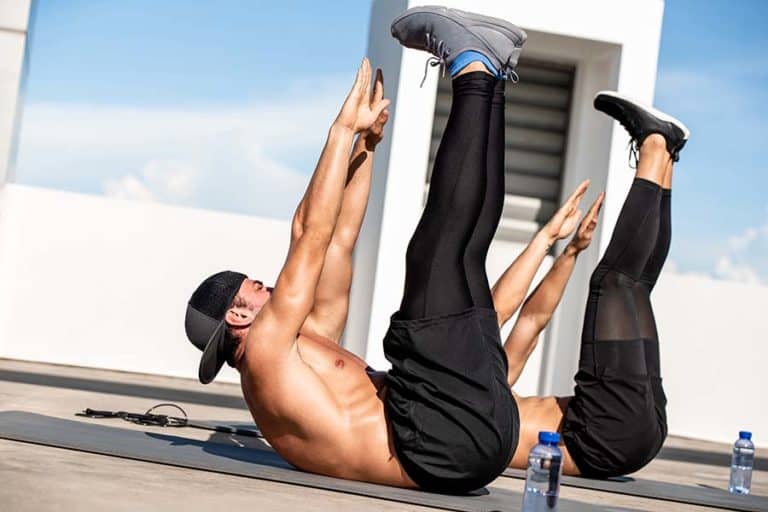How To Do Ring Muscle Ups? Ring Muscle Up Technique Guide

Muscle-ups overview | How to do | Sample progression plan | Variations | Benefits | Safety Tips
Ring muscle-ups are an advanced form of calisthenics movement that requires a combination of strength, technique, and coordination.
Muscle-ups, particularly ring muscle-ups, involve pulling yourself up to rings and transitioning into a dip.
This is obviously not an easy exercise to perform. We will guide you on how to do ring muscle ups and provide a 1-week progression plan to help you achieve your goals safely.
What is a muscle up?
A muscle-up is a challenging gymnastic exercise that involves a combination of a pull-up and a dip. It requires the use of upper body strength and coordination to lift the entire body up and over a horizontal bar or set of rings.
The movement begins with a pull-up, followed by a transition where the body is pulled up and forward, and then finished with a dip at the top of the movement.
What are kipping muscle-ups?
Kipping muscle-ups are a variation of the muscle-up exercise that involves using a swinging motion to generate momentum and assist with the execution of the movement. Unlike strict muscle ups, kipping muscle ups demand less upper body strength.
What are ring muscle-ups?
A ring muscle-up is a variation of the muscle-up exercise that is performed using gymnastics rings instead of a bar. The rings add an extra level of instability, making it more difficult to control the movement and requiring more upper-body strength and stability.
The ring muscle-up involves a similar movement to the standard muscle-up but with the added challenge of maintaining balance and control of the rings throughout the movement. It is a highly advanced exercise that requires a significant amount of practice and strength to master.
How to do ring muscle-ups?
Ring muscle-ups are an advanced bodyweight exercise that requires significant upper-body strength and control. Practice each step of the movement listed below carefully, and progress slowly to avoid injury.
Here is a detailed step-by-step guide on how to do ring muscle-ups:
- At the starting position, your arms must be fully extended, clutching the rings with a false grip. The false grip hold is a hand position involving wrapping your hands around the rings with your palms facing each other and your thumbs pointing toward the ceiling.
- Transition to a false grip pull-up by pulling the body towards the rings, engaging your back muscles, and keeping your chest forward. Keep your elbow close through the transition.
- Lower yourself back down to the dip position by reversing the movement. Your core should go through the hollow and arch positions through the transition phase.
- Combine the pull-up and dip portions of the movement and repeat the ring muscle-ups.
1-week Sample ring muscle up progression plan for ring muscle ups
It is no mean task to be able to perform ring muscle-ups. Normally, only advanced athletes are able to perform ring muscle-ups.
However, by following a proper progression plan, you can build the required grip, upper-body strength, and coordination to perform ring muscle-ups.
What is a ring muscle-up progression plan?
A progression plan for your ring muscle-up workout basically involves a series of progressive movements or exercises that gradually increase in difficulty to help you build up the strength and technique required to perform ring muscle-ups.
The ring muscle-up progressions may involve starting with basic pull-ups and dips and gradually progressing to more advanced movements like false grip holds and strict ring muscle-ups. A well-designed progression plan can help you build strength, improve your technique, and achieve your goal of performing ring muscle-ups.
Here is a sample 1-week progression plan for ring muscle ups:
| Day | Exercise | Sets and reps |
| Monday | Ring pull-ups Ring dips | (3 sets x 5 reps) (3 sets x 5 reps) |
| Tuesday | Ring rows Ring push-ups | (3 sets x 8 reps) (3 sets x 8 reps) |
| Wednesday | False grip hang Arch to hollow swings | (3 sets x 10 seconds) (3 sets x 10 reps) |
| Thursday | Rest day | |
| Friday | Kipping muscle-ups Ring dips | (3 sets x 3-5 reps) (3 sets x 8 reps) |
| Saturday | Ring rows Ring push-ups | (3 sets x 10 reps) (3 sets x 10 reps) |
| Sunday | Rest day |
List of ring muscle-up variations
The ring muscle-up can be varied in a lot of different ways. Here are some of the most popular variations:
- Kipping Ring Muscle-Ups: This variation involves a dynamic kipping motion to gain momentum and complete the movement with more ease.
- Weighted Ring Muscle-Ups: Adding weight to the ring muscle-up can increase difficulty and challenge your muscles even more.
- Negative Ring Muscle-Ups: This variation emphasizes the negative portion of the movement, which is the eccentric phase.
- Banded Ring Muscle-Ups: Adding a resistance band around the rings can allow you to use less strength and increase control during the exercise.
- Baby Ring Muscle-Ups: This is a regression of the movement and can be used to practice the individual components, such as the chest pull, ring dip, and transitions.
- Assisted Ring Muscle-Ups: If you’re having difficulty performing the full movement on your own, this variation allows you to use assistance from a partner or a weight to complete the exercise.
- Reverse Grip Ring Muscle-Ups: This variation involves performing the pull-up with an overhand grip instead of an underhand grip, which can be more challenging and target different muscles in the back and shoulders.
Benefits of ring muscle up
Muscle pull-ups in most forms are extremely beneficial. Ring muscle ups, in particular, add another layer of challenge and increase the difficulty of the exercise. The instability of the rings during the movement strengthens your core and shoulder muscles and improves coordination and control.
Ring muscle-ups work your upper body muscles(chest, back, arms, and abdominal) all at once so you can build upper body strength faster. Let’s analyze the important benefits of ring muscle-up exercises in a little more detail:
1. Grip Strength
Ring muscle-ups are performed with a false grip, which puts extra pressure on the wrists and forearms. Moreover, a standard ring muscle-up progression requires you to practice several grip strength exercises. This builds your overall grip strength(both a false grip and a neutral grip).
Developing grip strength through ring muscle-ups can have a carryover effect. It improves performance in other exercises, such as deadlifts and pull-ups. You can expect everyday functional benefits, such as opening jars and carrying heavy objects.
2. Arm strength
This benefit is almost self-explanatory. Ring muscle-ups require more arm strength than regular pull-ups due to the instability of the rings and false grip positioning.
Additionally, the explosive nature of the exercise helps you build more strength. One study suggests that explosive exercises can greatly improve muscular strength [1]National Library of Medicine: Explosive type of moderate-resistance training induces functional, cardiovascular, and molecular adaptations in the elderly, power, and functional performance.
3. Upper-body strength
A study published in the International Journal of Exercise Science [2]International Journal of Exercise Science: COMPARISON OF MUSCLE ACTIVITY DURING A RING MUSCLE UP AND BAR MUSCLE UP observed that the Ring muscle-up “creates a more unstable environment” than other muscle-up exercises like bar muscle-ups. This factor results in higher activation of smaller muscle groups, such as the biceps brachii and forearm flexors.
4. Core strength
To successfully execute a ring muscle up, you have to keep your core muscles activated throughout the entire motion.
Starting from the initial pull-up, transitioning over the rings, and finishing with the final ring dip, the core muscles are an important part of the effective and safe execution of this exercise.
The hollow body position, which is a fundamental position used in gymnastics movements like the ring muscle up, requires a strong core to maintain proper form. Core strength and stability are also necessary for the chest pull and transitioning from the hollow to arch positions during a ring muscle up.
Performing kipping ring muscle-ups, which involve a dynamic kipping movement, can further increase core strength and endurance. To complete the movement, both the upper body and core muscles need to work together in a coordinated manner to generate enough momentum.
5. Coordination and strength
Performing ring muscle-ups require immense strength and controlled movements. During the exercise, you need to focus on maintaining stability in your core and making quick transitions between pull-ups and dips.
The movement involves coordinating the muscles in the upper body, core, and lower body to perform a fluid and controlled movement.
6. Shoulder mobility
The ring muscle up involves a broad range of motion for the shoulders. This exercise demands a combination of strength and flexibility, which in turn, can improve shoulder mobility.
There is a considerable amount of shoulder engagement throughout the ring muscle-up movement. The transitions between ring pull-up and ring dip require squeezing your shoulder blades together, rolling the shoulders forward, and maintaining a tight midline throughout the movement.
7. Higher body control and body awareness
The ring muscle up also requires a high degree of proprioception [3]ScienceDirect: Proprioception, which is the ability to sense the position and movement of your body in space. As such, it can provide several benefits related to body control and body awareness.
This can lead to greater mindfulness of your body position and movement patterns and reduce the risk of everyday injuries.
Another direct result of this is what is known as the mind-muscle connection. This refers to the ability to activate or engage certain muscles during an exercise consciously. With improved body control, you can achieve better muscle activation and, thus, improved body composition.
Tips for injury prevention and recovery
Although ring muscle-ups are beneficial, they can also lead to injuries if you don’t follow proper technique and practice good form. Here are some tips for preventing and recovering from any potential injuries:
- Warm up before performing ring muscle-ups. Do dynamic warm-up exercises like arm circles, jumping jacks, and burpees for 5–10 minutes before starting your workout. This will help you activate the muscles needed for the exercise and reduce injury risk.
- Progress gradually. It’s important to start with basic exercises first, such as pull-ups and dips, before attempting more advanced variations of ring muscle-ups like false grip hold or kipping muscle-up exercises.
- Use proper form during the exercise to avoid overstretching or excessive stress on your joints and muscles.
- Avoid overtraining by giving yourself adequate rest periods between workouts and varying your exercises.
- Use a foam roller or lacrosse ball to massage your muscles after each workout session. This helps reduce muscle soreness and prevents injuries.
- Take proper breaks in between sets so that your body can rest, recover, and prepare itself for the next set. This helps you maintain quality form and prevents fatigue from setting in too quickly.
- Listen to your body. If at any point during or after an exercise session, you feel pain or soreness, stop immediately and seek medical attention if needed.
Conclusion
Consistent training and proper form are the keys to learning how to do a ring muscle up. The 1-week progression plan provided above is an excellent way to build up the necessary strength and technique gradually.
Remember, ring muscle-ups require patience and persistence. Start with the basics, focus on technique, and progress slowly.
References
| ↑1 | National Library of Medicine: Explosive type of moderate-resistance training induces functional, cardiovascular, and molecular adaptations in the elderly |
|---|---|
| ↑2 | International Journal of Exercise Science: COMPARISON OF MUSCLE ACTIVITY DURING A RING MUSCLE UP AND BAR MUSCLE UP |
| ↑3 | ScienceDirect: Proprioception |







